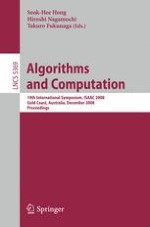This volume contains the proceedings of the 19th International Symposium on Algorithmsand Computation (ISAAC 2008),held on the Gold Coast, Australia, December 15–17, 2008. In the past, it was held in Tokyo (1990), Taipei (1991), Nagoya (1992), Hong Kong (1993), Beijing (1994), Cairns (1995), Osaka (1996), Singapore (1997), Daejeon (1998), Chennai (1999), Taipei (2000), Christchurch (2001), Vancouver (2002), Kyoto (2003), Hong Kong (2004), Hainan (2005), Kolkata (2006), and Sendai (2007). ISAACis anannualinternationalsymposiumthatcoversthe verywide range of topics in the ?eld of algorithms and computation. The main purpose of the symposium is to provide a forum for researchers working in algorithms and theoryofcomputationfrom allovertheworld.In responseto ourcallfor papers, we received 229 submissions from 40 countries. The task of selecting the papers in this volume was done by our Program Committee and many other external reviewers. After an extremely rigorous review process and extensive discussion, the Committee selected 78 papers. We hope all accepted papers will eventually appear in scienti?c journals in a more polished form. Two special issues, one of Algorithmica and one of the International Journal on Computational Geometry and Applications, with selected papers from ISAAC 2008 are in preparation.
